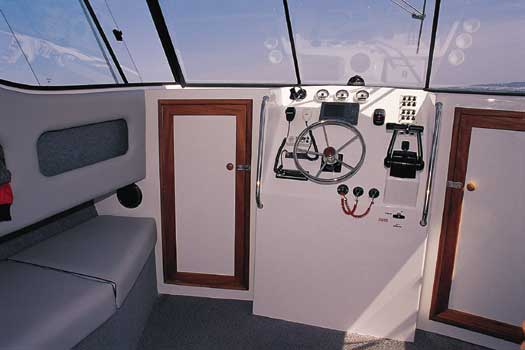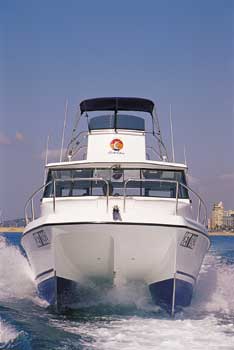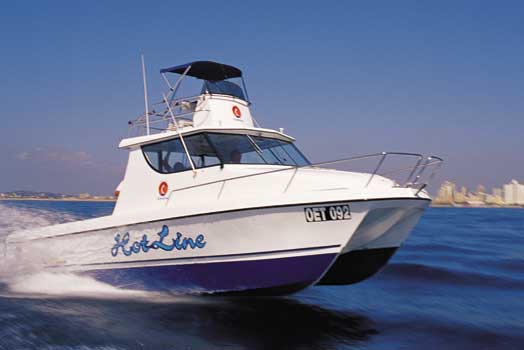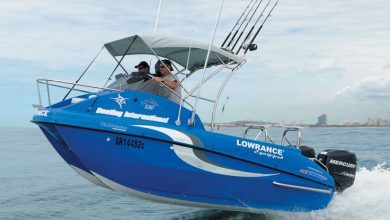Cobra Cat 900 – A 9 metre Craft
(SKi-BOAT November/December 2001)
Sitting at the helm on the flybridge of his new Cobra Cat 900, Sean van Veïjeren looked pleased. No, ecstatic. After all, his vision and dreams of the last couple of years had become a reality. The materialisation of an embryonic idea, his idea of the perfect boat, was germinated during a number of sorties abroad in his quest for the only fish that counts in his mind — marlin.
With these big fish being his only goal and Sodwana Bay his primary fishing venue, he wanted a boat that would give him the major advantages of a sportfisher, yet could be launched and retrieved through the surf at Sodwana.
Sean discussed his concept with Geoff and Mike Barnes of Mallards Boating, outlining what the next Hot Line needed to be and what he wanted her to accomplish. So began the planning, building and finishing of the Cobra 900, culminating in the launching of Hot Line off the beach at Vetch’s Pier in Durban.
I was one of a number of people privileged to witness her sea trials. Also there were Piet van Dyk, a doyen of marlin fishing at Sodwana, and his son, Charles, both who had flown in from Malelane. It was an unforgettable experience.
I have watched this craft’s progress from the drawing board, through the plug-making stage to its almost final completion. I have to admit that at times I was in two minds about the viability of the project, but as the boat neared completion, I began warm to the idea.
I knew Geoff had many a sleepless night worrying about this new craft. Therefore, I could appreciate that the eventual launch and sea trials lifted the proverbial weight of the world from his shoulders.
When I saw the craft on the beach, having been towed from the confines of the factory by Team Hot Line’s Unimog, I was taken aback by the size of the rig and felt quite helpless as I stood by in my Toyota Raider. If it got stuck, it would have been like David trying to help Goliath.
With many ifs, buts and maybes still in my mind, and a complement of four aboard, the nine metre (30ft) Cobra was run into the sea off her trailer with the ease of an exercise practised a hundred times. We were all surprised, indeed ecstatic and relieved that the mission had been accomplished with such ease. I wish the event had been captured on video so that we could view the launch in slow motion, for it seemed so easy. What’s more, the Unimog hardly got its tyres wet.
With hindsight we noted that when the boat commenced its slide down a 30ft virtual bed of rollers, it was already 35ft out into the ocean. When off the trailer it was another 30ft. More than 60ft out to sea off Vetch’s puts one into deep water. But Geoff had her turned and heading out to sea quicker than I could have done with a 20ft craft.
 Sean has selected twin 200hp Mercury 2-stroke Optimax outboards to power Hot Line, and power her they certainly do as I eventually established after I was allowed to take over Hot Line’s controls and put her through her paces.
Sean has selected twin 200hp Mercury 2-stroke Optimax outboards to power Hot Line, and power her they certainly do as I eventually established after I was allowed to take over Hot Line’s controls and put her through her paces.
I sincerely hope that the thrill of taking the controls of a new craft never diminishes. After testing 138 new craft over 23 years, I was still just as hyped up with the Cobra 900 as if it had been my own new boat.
With a crew of seven aboard I eased the throttles marginally forward and felt the 17-pitch four-blade counter-rotating props bite the water. Then began what was to be a few hours of very interesting and exciting boating.
Fortunately, only a gentle north-easterly wind was blowing, the sea relatively calm with a fair chop and swell from a stormy NE the previous day.
Yes, it would have been nice to try her in really big water, but if one is totally realistic, having a moderate sea allows one more permutations to evaluate a craft overall and not merely her ability to survive in big water. Indeed, by increasing speed, a small-to-medium sea can produce hull-over-water performance characteristics that would never manifest themselves in a big sea.
I set out, gradually increasing speed as I became more and more confident with her performance, and settled on the correct trim positions for the prevailing sea. As the Furuno GPS constantly displayed our SOG, I was able to maximise speed to revs and craft trim, as well as plot speed in knots to motor revolution over a wide range of revs/speeds.
In the range of 3 800 to 4 200 revs, which is generally the most economical in respect of litres-per-nautical mile travelled, we ranged between 18 and 23 knots SOG. In short bursts she achieved nearly 30 knots, with revs peaking at 5 500. Believe it or not, with a crew of seven and almost full fuel tanks, she got onto a plane on one motor and achieved a maximum speed of 14 knots.
In my opinion, this craft is much more of a sportfisher than a ski-boat, even an enlarged ski-boat. Indeed, it’s very hard to put her into one particular category as both looks and performance tug in opposite directions. One moment she feels like a ski-boat, the next a sportfisher.
To my mind, from a purely angling aspect, I like fishing from a ski-boat. However, I am the first to concede that when trolling for billfish, sails and marlin, strikers hold a lot of advantages. “So what are you trying to say,” you may well ask? To be honest, on the day I couldn’t make a clear descision as to how to exactly categorise this craft; she just seemed to extend the advantages of both, the best of both worlds.

But you’ll have to take a trip aboard this craft to understand what I am trying to say.
Suffice it to say that at sea she rode beautifully, especially during the three major tests of a craft’s performance, slow troll speed, kona troll and cruising at 18/20 knots. Let’s face it, 95% of our boating falls within these categories. I was able to experience all these aspects as skipper as well as crew member when others took the helm.
Sitting on the flybridge, gazing into the water that was stretching aft, I saw flat water for lures to work, as well as a few back wake waves down which big konas could be run from each of the outriggers. Boy oh boy — I could already visualise two teasers and a full array of lures working. From my lofty perch, this lapse into fantasy could only have been bettered by the sight of a billfish, all lit up and hungry for a lure.

Talking marlin fishing, backing up and manoeuvring is a vital part of fighting a big fish, and I had to test Hot Line’s response under these conditions. Unfortunately, with outboards one can never get the response that is found with shaft-drive propulsion units and rudders. Furthermore, the twin 200 Mercuries had to have their trim lock modified for beaching which restricted reversing to slow astern.
When one looks at the torque required of these monster motors which are able to push this big craft at 30 knots, it’s not surprising that when the reverse happens, the trimlock system gives in and the motors lift themselves out of the water. In times of high tension, Sean will have to watch that reverse thrust.
Once the flybridge controls have been finally adjusted and loosened up, she will be fine. As it was, I was able to reverse at a reasonable speed and she turned readily as if to follow a fish.
The final test was in the swell that was building up over Vetch’s. This was a necessary test because, after all, this craft is expected to surf launch at Sodwana. Turning such a big craft after coming down a swell and getting her into a position to take on the next wave was interesting. After accepting the resultant lag times due to size, I was impressed at her turning capabilities and her out-of-the-hole performance.
“We heard her cavitate,” said an onlooker or two from the beach, but I certainly didn’t. I used the full extent of her power in the turns and did not experience any prop slip whatsoever. The sound they heard was no doubt the different low roar of the big 200hp Mercury 2-strokes when the throttles were opened fully in one thrust.
Finally, it’s out-of-the-hole performance that is vital. Yes, she takes marginally longer to get onto the plane than a 20ft ski-boat, but once the motors are fully run in and Sean has got to know his new mistress, I doubt he will find her much different to his previous 22ft Hot Line. Indeed, the torque of the Mercury 200 2-strokes was awesome and I admit to being surprised at her get up and go.
Taking her out of the water was, to everybody’s amazement, a very simple undertaking. Geoff ran her up the beach at 4 000 revs in the conventional manner, cutting to neutral as she was about to hit sand, and let her glide up. She ended high and dry, about 1H boat lengths up the beach.
After positioning the trailer with the Unimog and overcoming a problem of the Crosby clamp slipping on the winch cable, she was loaded in about 40 seconds. The more rollers under the hull, the easier she rolled. By the way, the rollers are all on bronze bushes. As one guy remarked, it was “… easier and quicker than loading my six-metre craft”.
I have purposely devoted more of the review to the craft’s performance than the layout and finishes, but for the specific reason that most readers will want to know more about her capabilities at sea than the custom designed interior.
We also know that any boat coming out of Mallards Boating’s factory will be exceptionally well finished, with an enormous amount of thought put into all aspects of her design.
Because Hot Line is a marlin boat, Sean has ensured that the fishing deck is practically designed to fight even the biggest marlin off our coast.
The fighting chair and outriggers were not quite ready at the time of her sea trials, but from what I have seen of them they will make the craft “marlin perfect”. The cockpit, gunnels and transom are the right height to provide the deck crew with all the protection and support they could need when tracing a good fish.
 In designing the main saloon, Sean, Geoff and Mike have opted for practical simplicity, finished to very high standards.
In designing the main saloon, Sean, Geoff and Mike have opted for practical simplicity, finished to very high standards.
I beg the understanding of the staff and management at Mallards Boating for not devoting more words to complimenting the ideas incorporated into the craft, as well as the way the work has been completed. Suffice it to say — everything is outstanding! They must be extremely proud of the finished Cobra 900, for only they will ever know the extent of effort that has gone into Hot Line.
Mallards cc member Harry Naidoo — “perfection” is his middle name — was closely involved in the manufacture of the new Cobra 900 and spent hundreds of hours personally developing the moulds to ensure that the desired finish was achieved. A lot of credit for the high quality of the end product is, no doubt, due to him.
Over the next three months, hundreds of the country’s top marlin anglers will literally crawl over this craft at Sodwana and see for themselves all the features she boasts. Indeed, I am looking forward to watching her in the surf in November during the OET competition.
For those who won’t be at Sodwana and are not satisfied with photographs accompanying this article, the next Cobra 900 is in the mould. She will be up and running in a few months.
In conclusion, it was a bold step both Sean and Mallards Boating have taken — a 30ft sportfisher that is trailerable and able to be launched in the surf. Whether this craft is used in a marina-type operation or the purpose for which she was designed, I have no doubt she will meet the stringent requirements of serious big game anglers. Indeed, the Cobra 900 is one hell of a boat.
She will surely find a comfortable niche in the market, situated nicely between the bigger ski-boat and the much more expensive sportfisher.






